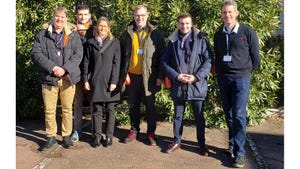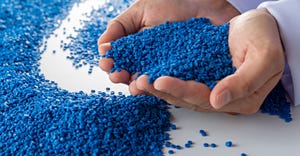Troubleshooting toolkit for injection molders
September 8, 1998
Molders have three places to get technical expertise these days, says Ken Kerouac, a technical service expert for Dow's larger injection molding customers. During a molders' clinic at Antec in May 1998, Kerouac talked about today's technical service and the tools you need to help troubleshoot your own operation.
One source of help is suppliers of both material and primary or secondary processing equipment. Depending on the nature of the relationship, this technical service could range from a full-time, on-site technical representative to a 1-800 phone-in system.
Another source is independents, usually consultants. They are rapidly filling a niche in the industry as the larger suppliers refocus their technical resources on a smaller number of strategic, higher value-added opportunities. Independents do not often have their own large-scale processing and analytical facilities; what they usually bring is extensive field experience and a well-developed network of contacts for access to other technical resources.
The last option is self-taught or in-house expertise. In a fast-paced, just-in-time production environment, every minute a molder spends producing scrap or shutting down a molding operation while awaiting answers from outside technical support amounts to wasted dollars. Molders are investing more in the training of their own staff to raise the overall level of expertise within the company.
The Proper Tools
Whatever the source of expertise, troubleshooters and problem solvers need tools to diagnose molding problems. After all, the most difficult part of troubleshooting is not implementing the solution to the problem, it is diagnosing the problem in the first place. Proper tools are critical for such investigations. The number of tools in which a company will invest and their degree of sophistication will depend on things like existing technical support from other sources, budget, in-house expertise, the complexity of the typical molding job, the kind of tools incorporated into the equipment, and material issues.
Problem solving tools can be divided into three tiers, from the more basic to the more sophisticated (and expensive). The basic tier may seem trivial and obvious, but how many times have you been standing next to a machine without one of these basic tools and found yourself handcuffed because of it?
Basic Tools
Material supplier data and property sheets--basic processing information
Troubleshooting charts--generated by the material supplier or other source
Molding record sheets--for documenting process conditions and changes made in the course of the trial
Part/Tool prints--should be on hand to understand cooling line layout, other details
Steel rule or hand-held calipers--for simple dimensional measurements
Flashlight
Lighter--one example of its use can be to heat a part to determine if a defect is an air bubble or a vacuum void
Stopwatch--for measuring times of different segments of the molding cycle
Fold-out mirror--for viewing areas of the machine or mold not easily accessible
Snips--for cutting samples out of molded parts
Sample containers--for safely storing either molded parts or pellets for transport
Basic hand tools--screwdrivers, brass tools for working in the mold, soft mallets, etc.
Concentrated vinegar--can be swabbed on parts for qualitative molded-in stress evaluations with some materials
Radius gauge--for measuring sprue bushing and nozzle radii
Diameter gauge--can be inserted into nozzle orifices, bosses, or water lines to measure diameter
Masking tape--can be used to tape off vents to evaluate their effectiveness and contribution to material burning
Paint/Grease pens--for marking parts and sample containers
String--for laying out and measuring flow length in more complex part geometries
Camera (still or video)--for visual review at a later date and to make sure everyone involved has the same understanding of the problem
Intermediate Tools
Melt pyrometer--for measurements of polymer melt and mold surface temperature
Purging compound--for faster, more thorough barrel clean-out between trials
Polarizing lenses--for qualitative evaluation of birefringence in clear parts
Electrical meter--for testing thermocouples, heater bands
Hot plate--with foil and a small press for qualitative evaluation of moisture content in material
Dew point meter--for checking dryer capability
Scale--for part weight measurements
Color/Gloss standards--for quick measurements of part quality
Portable gloss meter--for on-site measurements of Gardner Gloss
Flow meters--can be put in-line with supply and return water to measure temperature, pressure, and flow rate of water through the mold
KBR plates--can be used to swab a mold surface to collect any deposits or residue. Unlike paper towels or other kinds of cloth, it will not contaminate the sample under analysis
Band saw--for cutting larger samples out of larger parts
Advanced Tools
Data acquisition equipment--for collecting data on pressures, times, and positions
Pressure transducers--mounted in the mold for collecting cavity pressure data
Flow analysis software--for simulation of the desired process and comparison with reality
Troubleshooting/Problem solving software packages
Portable color lab--for evaluating color consistency and comparison to the standard
Parting line sensor--to monitor relative movements of the mold half in response to plastic pressure
Strain gauges--mounted on the tiebars to measure any imbalance in applied clamping force
Moisture analyzer--for quantitative measurements of moisture content
Ultrasonic or magnetic gauge--for precise thickness measurements
Portable X-ray device--for nondestructive evaluation of part interiors (such as bubble formation in gas-assist molding)
Analytical instruments--such as infrared spectrophotometry (IR), gel permeation chromatography (GPC), and differential scanning calorimetry (DSC) to look at such material characteristics as composition, molecular weight, and degree of crystallinity
Microscope--used to look at the material morphology and skin/core structure and orientation
You May Also Like


